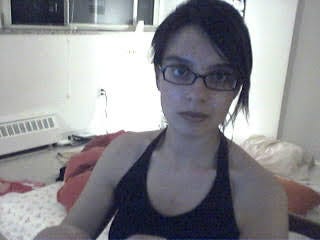Four weeks ago I sat in a reclining medical chair and lay in meek stillness while precision lasers burned off parts of my corneas, putting an end to my close-to-lifelong nearsightedness. I didn’t know going in that you can actually smell the burning — the scent of my own body going up in smoke is a sliver of a thing I now share with condemned sixteenth-century heretics, though with much happier results. The whole operation took scarcely more than five minutes. The doctor told me to look at a red dot; the dot looked clear at first and then started to swim, and then went out. When it was over, my eyes were fixed.
I was seven or eight years old when my mother first realized I needed glasses. We were on the ferry from Vancouver to Victoria and she asked me to choose something to eat from the cafeteria menu. I complained that the menu was too far away for me to read, and soon after she made an appointment with the eye doctor. My first pair of glasses had pink frames, and I vividly remember wearing them that first day and being able to see individual leaves on the trees.
By junior high school, I’d figured out that most of the pretty girls in the pages of Seventeen magazine didn’t wear glasses. I asked for and was granted contact lenses, and started wearing them almost every day. The eye doctor explained that if the lens, balanced on a fingertip, looked like a poorly-made bowl instead of a well-made bowl, it was probably inside-out. The pink framed glasses sat in their case, coming out only in emergencies.
When the “hipster” fashion of the 2000s emerged, and aggressive acetate frames a-la Weezer became a signifier of cool, I reconsidered my contacts-only stance. At first my glasses were square and black, vaguely suggestive of Tina Fey in Mean Girls.
Then, during a stint living in New York, I discovered vintage frames — in particular, a shop on E 9th Street called Fabulous Fanny’s, with endless drawers of frames from past decades. To my collection I added a cat’s-eye aluminum pair with engraved flowers, and a set shaped like two enormous red squares (the prescription on those was never quite right). I had as many as four pairs in regular rotation.
The trend for chunky plastic frames seems never to have quite gone away, but I kept expecting fashion to shift back to lighter metal frames. Anticipating this, shortly after moving to Seattle I snapped up a brassy octagonal pair at a sample sale. After years of heavy plastic, they felt delightfully weightless and didn’t slip down my nose. I wore them happily until Walter, my golden retriever who was then a year old, chewed the arms up one day.
Glasses afforded me something other than fashion, however: a chance to change not just how I saw but how I was seen. Unusual frames like the cat’s-eye pair attracted attention, but certain other pairs were like camouflage. They have a way of blunting the distinctions of the face; they’re something to hide behind. Another disguise: for much of my career in tech, I deliberately wore glasses for interviews and important technical presentations. Whether they made me appear more intelligent and serious, as my superstition told me they would, I couldn’t say. For my most recent job hunt, I decided to ditch them.
My final pair of glasses was a capitulation to convention: Ray-Ban Wayfarers in tortoiseshell, popular enough to have their own Wikipedia page. It was these I wore to the laser clinic. Just before going in for the eye surgery, the doctor told me I could take my glasses off. I will never put them on again, I thought. But eyeglasses are one of those things whose former necessity makes them almost impossible to throw out. They’re now sitting in the drawer of my nightstand, and my closet contains, still, almost every pair I have ever owned.






